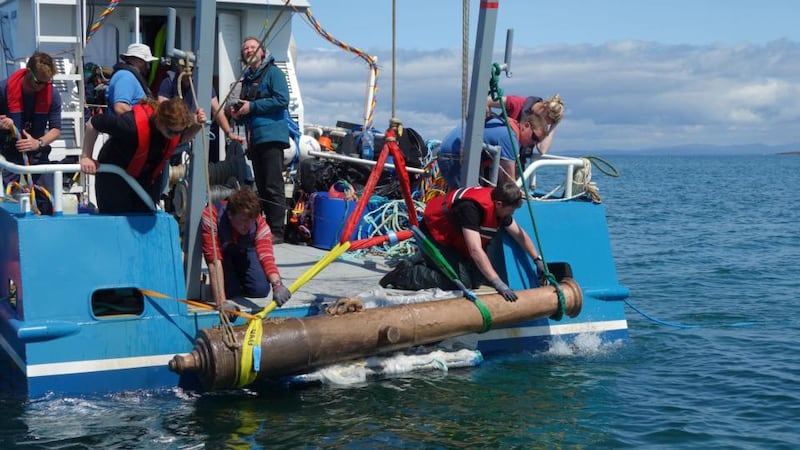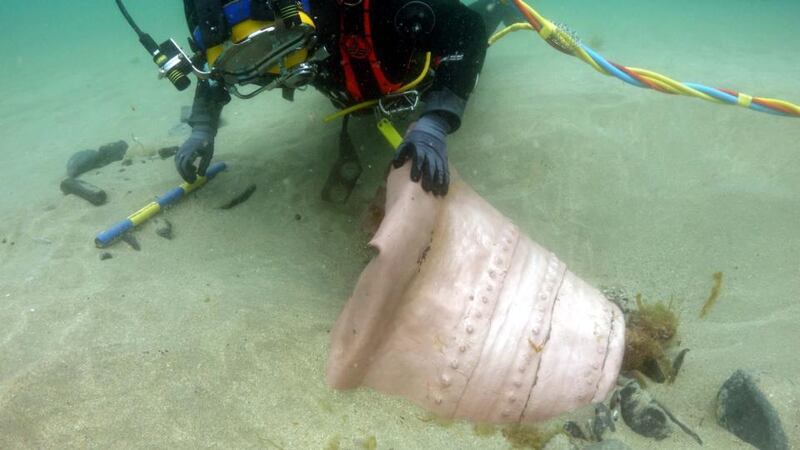Two hundred locals gathered at Mullaghmore harbour in Co Sligo on Monday as four bronze cannons that had lain for more than 400 years in a Spanish Armada wreck at Streedagh were transferred to the National Museum.
As onlookers marvelled at the detail on the artefacts, including one cannon apparently depicting a bearded St Peter holding the keys to heaven, it emerged that three more will be removed on Wednesday by divers from the underwater archaeology unit of the Department of Arts and Heritage.
One of these cannons is still in situ on the seabed at Streedagh where three Spanish Armada galleons were shipwrecked in 1588. Two others were recovered by divers in recent days from the wreck of La Juliana at Streedagh. They were placed in underwater storage in Mullaghmore pending transfer to the National Museum.


A campaign to establish a permanent Armada museum in Grange village close to Streedagh is gathering momentum. Minister for Arts, Heritage and the Gaeltacht Heather Humphreys, who visited the site of the wrecks in June said she was very much aware that the Grange Armada Development Association would like to see the material returned to the community to be exhibited locally when the conservation work was done.
Conservation
“I know that the National Museum would not stand in the way of such a proposal,” added the Minister, who pointed out that it could take up to two years for the conservation process to be completed.
Donal Gilroy, a member of the local association, pointed out that as well as the canons, recently recovered artefacts included a bronze cauldron and a wheel from a siege gun. He said local people were acutely aware of the link with the 1,100 Spanish sailors who had lost their lives at Streedagh in 1588. "This is their graveyard," he said.
The expert divers who were called in after local people recovered timbers from La Juliana following a violent storm last February, say the variety of artefacts illustrates its history.
Built as a trading vessel in 1570, it was later used as a warship during the ill-fated Spanish Armada campaign of 1588. The 860-ton La Juliana , which carried 325 soldiers and a crew of 70, was one of 26 ships from the Spanish fleet of 130 vessels that were lost around the coast of Ireland.
Submerged
Two other Armada ships,
La Lavia
and
Santa Maria de Vison
are submerged in sand at Streedagh, but locals have expressed concern about the security of
La Juliana
, which has been partly exposed by storms .
Ms Humphreys described the quality of material being recovered as remarkable. "The gun carriage wheels, designed for siege warfare on land, paint a very clear picture of the scale and intent of the planned invasion of England by King Phillip II of Spain, " she said.
The most elaborate of the recovered cannon depicting St Peter has two ornate lifting handles in the form of dolphins with looped tails.
The Minister thanked the local development association and Sligo Sub-Aqua Club for maintaining a watch over the site at Streedagh.
Mr Gilroy pointed out that just 12 of the 32 cannon on La Juliana had been recovered so far – three in 1985, two last June, four on Monday, with three more due to be removed from the sea on Wednesday.
Making the case for a permanent museum in Grange, Mr Gilroy added: “If you wanted a centre for the Cliffs of Moher, there would be no point having it in Merrion Square.”












